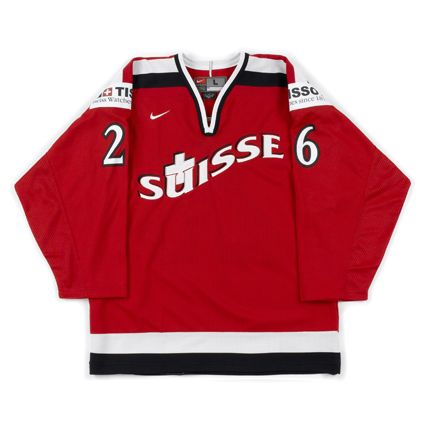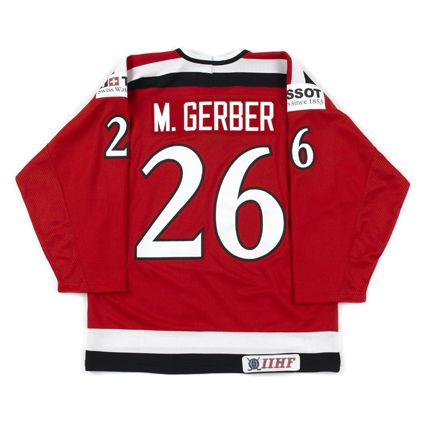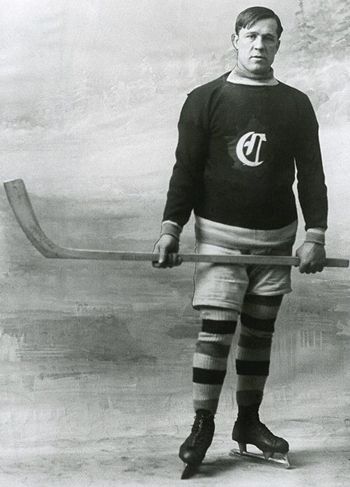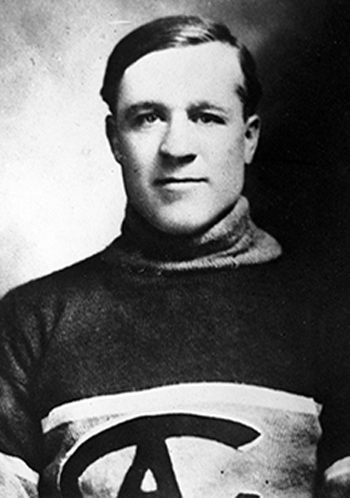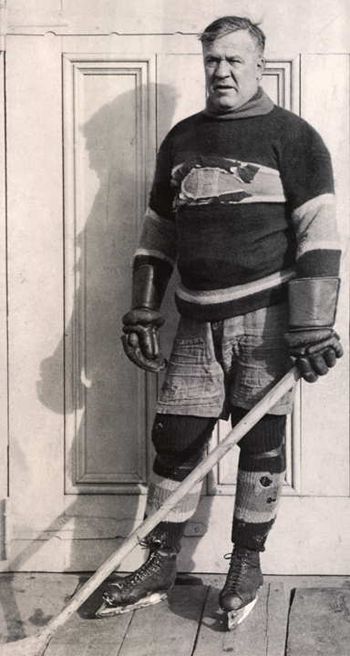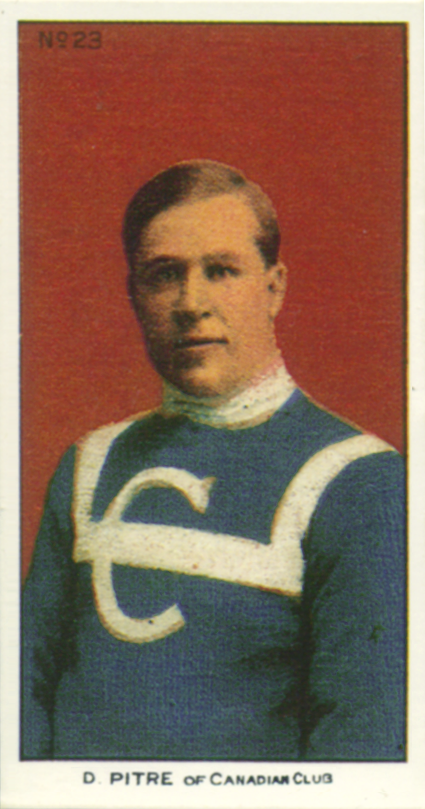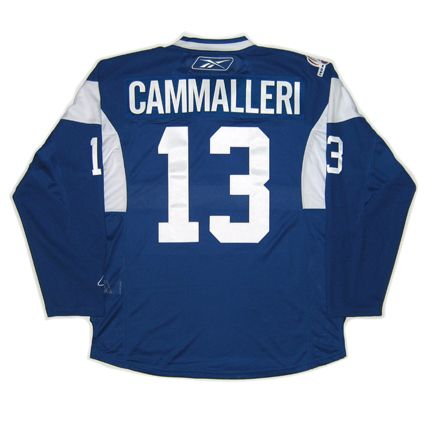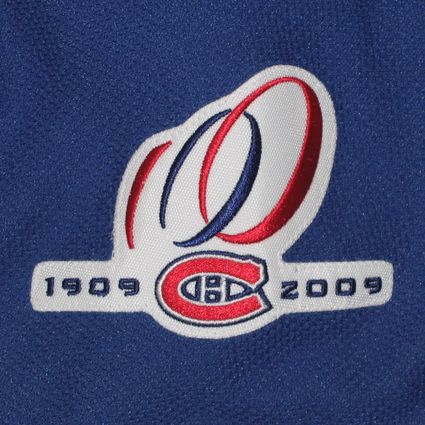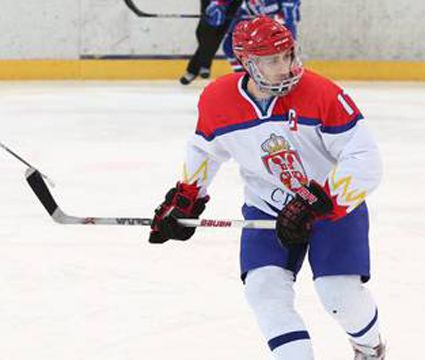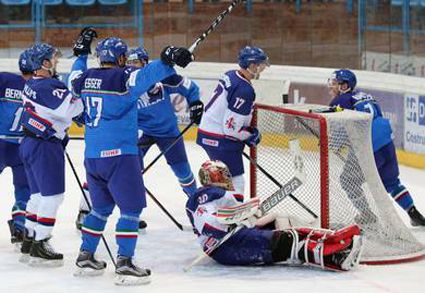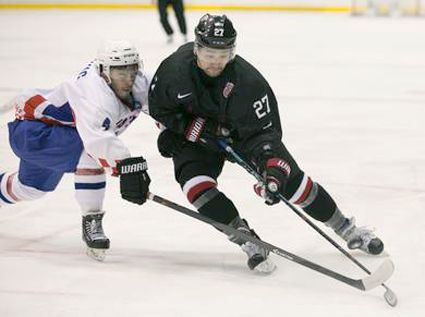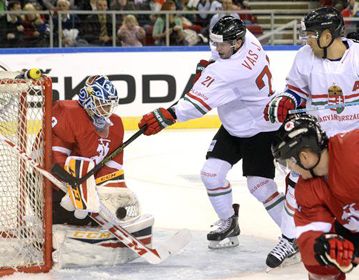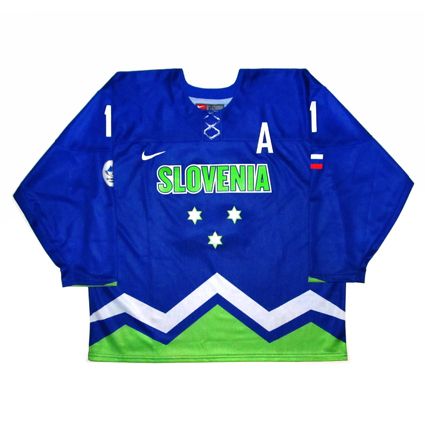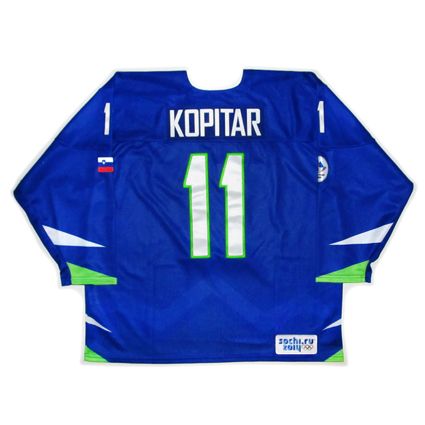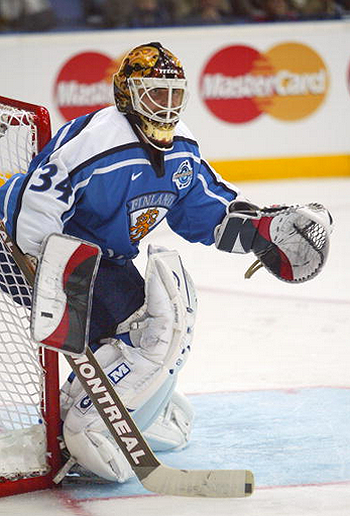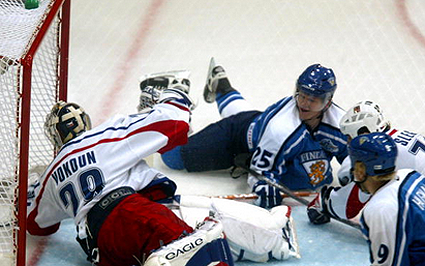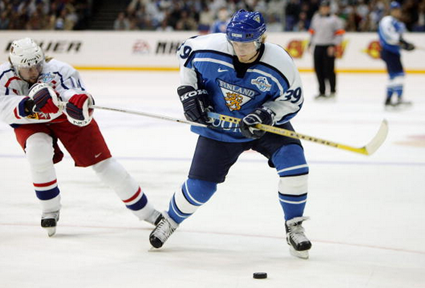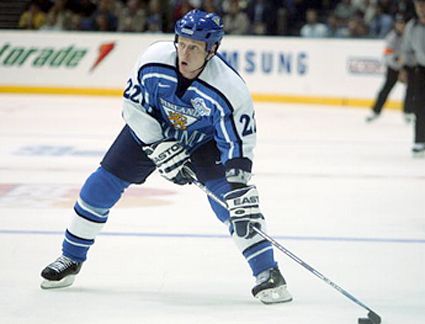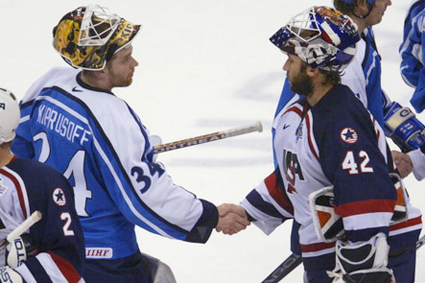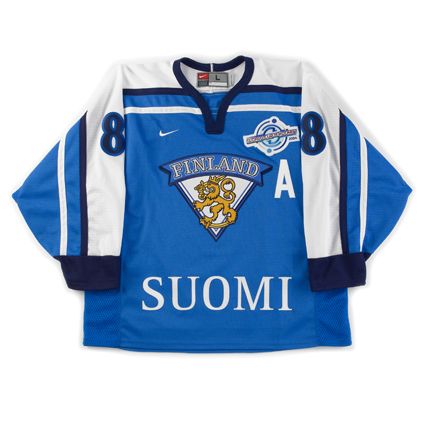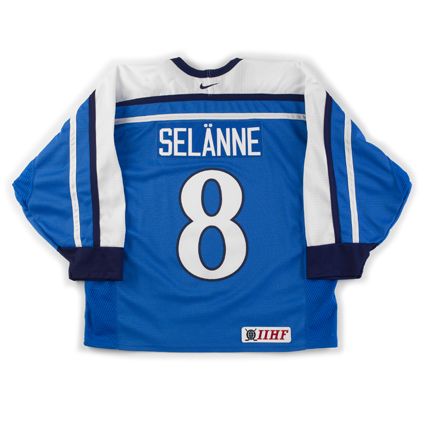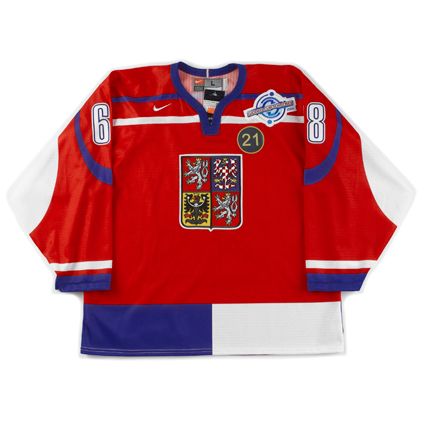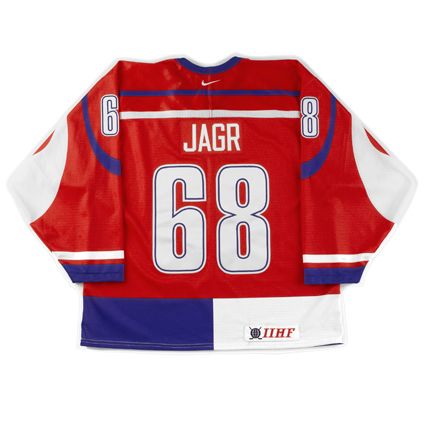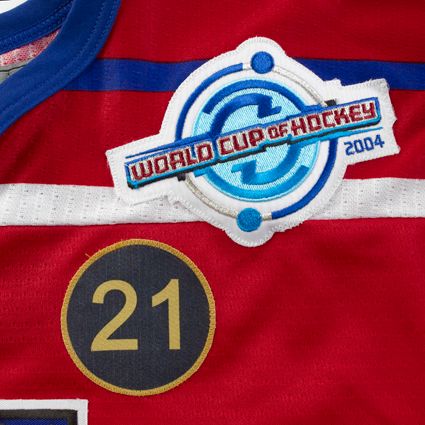After playing for the Montreal Nationals in 1903 and 1904 as an amateur,
Didier Pitre turned professional with the Michigan Soo Indians (also known as the American Soo Indians in deference to the club in the same league based in Sault Ste. Marie, Ontario) of the International Professional Hockey League, the first professional league in North America for the 1904-05 season, scoring 11 goals in 13 games. The following season of 1905-06 Pitre destroyed all that came before him, leading the league with 41 goals in 22 games. His final season with the Soo Indians saw him average over a goal per game with 25 in 23 games as well as being credited with 11 assists for 36 points in 1906-07.
Following the demise of the three season old IPHL, and with professional teams now having been formed back east in Canada, Pitre, born on this date in 1883, returned to familiar territory in Quebec when he signed with the Montreal Shamrocks of the Eastern Canada Hockey Association for the 1907-08 season. He would find the going tougher, being limited to 3 goals in 10 games.
For the 1908-09 season, he saw action in 5 games with the Edmonton Eskimos, 3 in the regular season and 2 during their unsuccessful Stanley Cup challenge against the Ottawa Senators. He was then signed by the Renfrew Creamery Kings of the Federal Hockey League, scoring 5 goals in 5 games. His season wasn't quite over yet, as he added an exhibition game with his first club, the Montreal Nationals, to his schedule and impressed with four goals.
He next joined the first year Montreal Canadiens of the National Hockey Association, scoring 11 goals in 12 games. Les Canadiens found the going rough, finishing in last place with a 2-10 record. Pitre continued to play for the Canadiens for three more seasons, increasing his goal total to 19 in 16 games in 1910-11, tied for the team lead with teammate
Newsy Lalonde and sixth in the NHA. For the 1911-12 season, Pitre was runner up in the NHA scoring race with 27 goals in 18 games. His final season with the Canadiens saw him again finish sixth in league scoring with 24 goals in 17 games, just one back of Lalonde for the team lead.
Pitre in 1910-11 with the second year Canadiens
For the 1913-14 season, Pitre was lured west by
Frank Patrick to be a part of his Vancouver Millionaires club in the Pacific Coast Hockey Association. Pitre's 14 goals and 16 points put him in the top ten in the PCHA scoring.
After one season our wast, Pitre returned to the Montreal Canadiens and immediately set a career high in goal scoring with 30 goals in 20 games, again finishing second in league scoring with 34 points.
On top of his game, Pitre immediately followed that with a career best 39 points in 24 games from 24 goals and 15 assists to win the NHA scoring championship for the 1915-16 season as the former doormats won the O'Brien Cup as NHA champions with a 16-7-1 record.
The Canadiens then hosted the Portland Rosebuds of the PCHA for the rights to the Stanley Cup. Montreal would win the first Stanley Cup in franchise history 3 games to 2, with Pitre scoring a hat trick in Montreal's 6-3 win in Game 3 on his way to leading the playoffs in goal scoring. Pitre played not only center, but also spent time at the rover position for the Canadiens.
Pitre during the 1915-16 season when he won the NHA
scoring title and the only Stanley Cup of his career
Pitre was second on Montreal in scoring behind Lalonde for 1916-17, but still scored more than a goal per game with 21 goals in 20 games plus 6 additional assists. His 27 points were sixth in the NHA. Montreal won the first half of the season with a 7-3 record, but the outbreak of World War I reeked havoc with the league and the 228th Battalion club no longer had time for hockey and the other Toronto franchise was suspended by the league in a dispute with their difficult owner
Eddie Livingstone, who the other owners wanted to be rid of.
Montreal won the two-game, total-goals playoff series with Ottawa 7-6 to advance to the Stanley Cup playoffs against the Seattle Metropolitans, who won the cup three games to one.
In a further effort to rid themselves of Livingstone, the other four NHA team owners disbanded the NHA and reformed a week later as the new National Hockey League. Pitre was again the second leading scorer on the club behind Lalonde, this time with 17 goals and 23 points in 20 games.
For the 1918-19 season, Pitre finished third on the Canadiens in scoring behind the league leader Lalonde and
Odie Cleghorn but was fifth in the NHL with 14 goals and 19 points in 17 games. Montreal won the NHL playoffs 4 games to 1 over the Senators to advance
to the ill-fated Stanley Cup Finals, which was played in Seattle. The
series was tied at 2-2-1 when the Spanish Flu Epidemic forced the
cancellation of the series, costing Pitre's Montreal teammate
"Bad" Joe Hall his life four days later.
Pitre, known for his size, speed and his hard shot, retained his place in the league's top ten in scoring in 1919-20 with 14 goals and 26 points but fell just shy in 1920-21 with 25 points, one point behind the 26 points needed to keep his streak alive.
The Canadiens were so deep at forward by this stage that during his final two seasons in the NHL, Pitre was moved to defense at age 38, in part thanks to his experience playing rover and taking the place on the blueline formerly occupied by Hall. This change led to him scoring only 2 goals and 6 points in 1921-22 and 1 goal and 3 points in 1922-23.
Pitre at the end of his career with Montreal in 1922-23
Pitre's final NHA, PCHA and NHL totals were 234 goals and 61 assists for 295 points in 270 games played and he was inducted into the Hockey Hall of Fame in 1963.
Today's featured jersey is a
1909-10 Montreal Canadiens Didier Pitre jersey.
This blue jersey with a white horizontal chest stripe and large "C" on
the chest was worn by Les Canadiens during their first ever season
while members of the NHA.
This jersey style lasted only
a single season, as was the norm for the Canadiens during their
formative years. In their first 16 seasons, Montreal would use 11
different jersey styles, including five in their first four seasons, in
stark contrast to their tradition of keeping their same iconic style
with only minor detail alterations since 1925.
Bonus Jersey:
The Canadiens revived their original 1909-10 jerseys as part of their
centennial celebrations during the 2008-09 and 2009-10 seasons. This was
one of six different styles worn as part of the centennial jersey
program.
This particular style was worn on November 21, 2009 in a 3-2 shootout loss to the Detroit Red Wings. Mike Cammalleri scored both Canadiens goals during the game.
This
jersey was scheduled to be worn one additional time on February 13,
2010, but the centennial jersey program was discontinued by the
Canadiens new ownership with two games left on the schedule, with the
other being on January 23, 2010 when their red and green
1910-11 jerseys were to have been worn, making these two styles the only ones to have been worn just once.
Our video selection today takes a look back at the formation of Les Canadiens in 1909.

